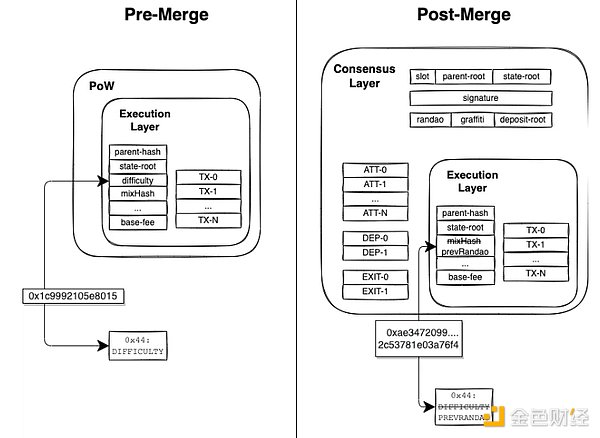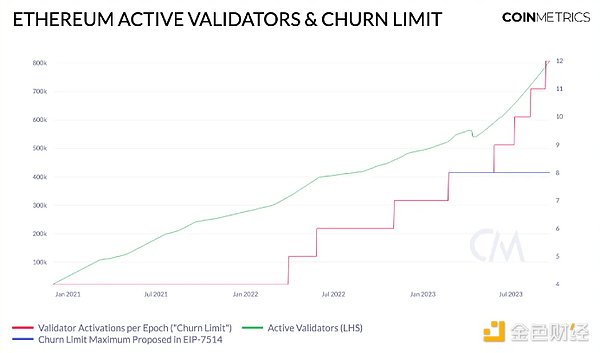Author: Matías Andrade Cabieses, Coinmetrics; Translation: 0xjs@金财经
With the highly anticipated Dencun upgrade, we are on the cusp of a major evolution of the Ethereum blockchain ecosystem. This update marks significant progress that enhances Ethereum’s capabilities by addressing some of the ecosystem’s most pressing challenges, such as unlocking Layer 2 scalability and enhancing security for node operators and validators.

Source: Coin Metrics Lab
In this article we delve into the details of the Dencun upgrade. We will explore the nature of the upgrade, proposed changes to the Ethereum execution and consensus chain, and some metrics that can help us monitor the progress of this upgrade.
What is Dencun?
Dencun is the nickname of the latest Ethereum upgrade, and its name comes from the unique fusion of celestial bodies and geographical locations ——This is the convention followed by Ethereum when updating. It combines Deneb, the first-level star of Cygnus, which represents the upgrade of the consensus layer, and Cancun, where Devcon 3 is held, which symbolizes the upgrade of the executive layer.
The Dencun upgrade must be carefully tested on various Ethereum testnets before launching on the Ethereum mainnet. This critical phase ensures that all new features work properly and any potential issues are addressed ahead of time. As of now, Dencun has been successfully activated on the Goerli and Sepolia testnets, and is planned to be activated on the remaining testnet Holešky. These testnet deployments are critical to fully test all different clients, especially for developers looking to examine the L2 impact related to blob expiration.
The anticipation surrounding Dencun’s upgrade is palpable, but the exact date of its mainnet launch has not yet been disclosed. After extensive testing in the testnet phase for 1-2 months, the Dencun upgrade is expected to transition to the mainnet around March or April. This meticulous approach highlights Ethereum’s commitment to ensuring stability and reliability, aiming to achieve seamless and efficient integration of the Dencun mainnet.
The Big Story: Blob Transactions and EIP-4844
One of the key elements of Dencun is EIP-4844, which introduced "blob carrying transactions". These transactions are designed to enhance data availability scaling within Ethereum. They provide a mechanism for on-chain applications to relieve L1 fee pressure by shifting demand to L2, which is supported by a more economical big data blob transaction format. These blobs, while not directly accessible by the EVM, are anchored by directly accessible promises. The format is designed to be compatible with the expected full sharding model, providing temporary relief to users currently experiencing high L1 fees.

Source: Coin Metrics Labs
The proposed EIP lists specific parameters, encryption technologies, and Improved Gas accounting method tailored for Blob transactions. It further describes the basics of execution and consensus layer validation, network impact, and blob-containing transactions. This EIP is a cornerstone of Ethereum’s scaling strategy and its move toward sharding, providing a temporary solution to limit the number of these transactions to a cap, consistent with a target of approximately 0.375 MB per block and a cap of approximately 0.75 MB.
The Deneb upgrade may reduce Ethereum’s fee revenue in the short term, as EIP-4844 will reduce fees paid for block space rollups by more than ten times. The success of this upgrade can be measured by several metrics, including:
L2 adopts blob transaction type
Reduce L2 sorter fee payment
Reduce transaction fees within L2
Increase blob fees, Making “spamming” data no longer economically viable
Long-term adoption of Ethereum as data availability (DA) compared to competing alternatives such as Celestia
< /li>
Upgrades affecting validators and staking operators
Expansion of services such as Lido and Rocketpool, as well as staking-as-a-service offerings from major players such as Coinbase, Binance and Kraken , has been considered one of the most important areas of active research within the Ethereum community to improve the security of the network. Some of these solutions, such as increasing the churn limit, simply reduce the rate at which new validators join the network.
EIP-4788: Beacon block root in EVM
EIP-4788 proposes to embed the hash tree root of each beacon chain block into the corresponding Ethereum Execution payload header. This involves storing these roots in smart contracts, allowing trust-minimized access to the consensus layer within the Ethereum Virtual Machine (EVM). This information enables providers of Liquidity Collateralized Derivatives (LSD) to reduce the scope of their operations to issue tokens and rewards in an automated and trustless manner through direct access to consensus layer data (when using oracles from trusted on-chain Machine price updates ETH price in case of rebasing token).

Source: Ethereum Foundation
EIP-7514: Increase maximum Epoch loss limit h3>
As the ETH pledge level increases, the consensus layer is under greater pressure. The increase in the number of validators results in an increase in gossip messages and an increase in the size of the Beacon state - our archived Lighthouse node takes up over 16TB! While the message volume and growth rate of Beacon status can be reduced by increasing the maximum effective balance (currently 32 ETH) (someone is actually exploring an EIP that would be used for this purpose), introducing such a change requires a delicate balance Behavior. It needs to ensure that the network remains accessible to individual validators while optimizing for scalability and efficiency.

Source: Coin Metrics Network Data Pro
EIP-7044: Permanent signature voluntary exit
The introduction of permanently valid signature voluntary withdrawal makes the design of staking operations simpler, enhancing the user experience and the security of staking operators.
EIP-7045: Increase the maximum attestation inclusion slot (Attestation Inclusion Slot)
EIP-7045 proposes to increase the maximum attestation inclusion slot in the Ethereum blockchain. This change will include slot expansion from attestation.slot + SLOTS_PER_EPOCH to the last slot of N+1 epochs, where N is the epoch containing the attestation slot. This proposal is a crucial change to the security of LMD-GHOST, enabling faster block confirmations and adopting new fast confirmation rules without negative security impacts.
EVM upgrade
The Ethereum Virtual Machine (EVM) is the core of Ethereum applications. Its language and features allow developers to create secure and efficient contracts, but like any language, it needs to evolve as pain points are identified and addressed. Many of the upgrades below will help simplify applications running on the EVM, reduce costs, and enhance the developer and user experience on the Ethereum network.
The introduction of the EIP-1153 Transient Storage Opcode and the EIP-5656 MCOPY instruction is a technological advancement that promises to optimize smart contract interactions and reduce the gas costs associated with complex operations. At the same time, EIP-6780's modifications to the SELFDESTRUCT opcode reflect a thoughtful response to evolving blockchain architectures, addressing issues with state changes and aligning with future architectural changes such as Verkle trees .
EIP-7516 adds a new opcode (BLOBBASEFEE) for accessing blob base fees, facilitating trustless delivery of L1 costs to rollup users based on on-chain prices. Additionally, it allows the creation of derivatives such as futures, options, and swaps based on blob fees.
Conclusion
The Dencun upgrade represents a huge shift in the development of Ethereum, solving current and long-term scalability, security and efficiency issues.
As the activation of the testnet shows promising results, the Ethereum community is full of expectations for the launch of the mainnet.
The proposed EIPs, especially those designed to optimize data availability and staking operations, will significantly enhance the performance and user experience of the network.
As the Ethereum landscape continues to evolve, it is critical that stakeholders, from validators to end users, stay informed and adapt to these changes.
 Huang Bo
Huang Bo







